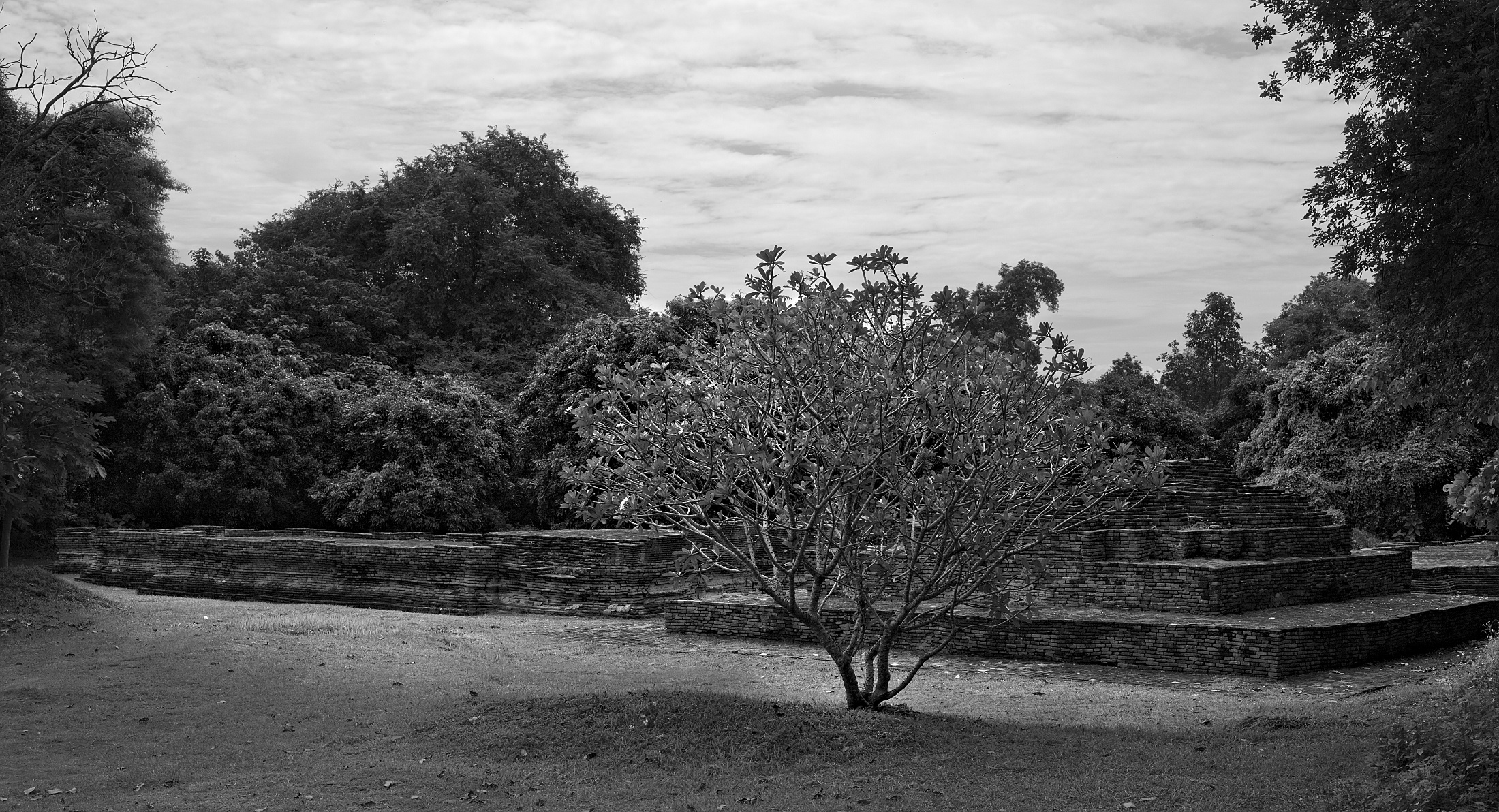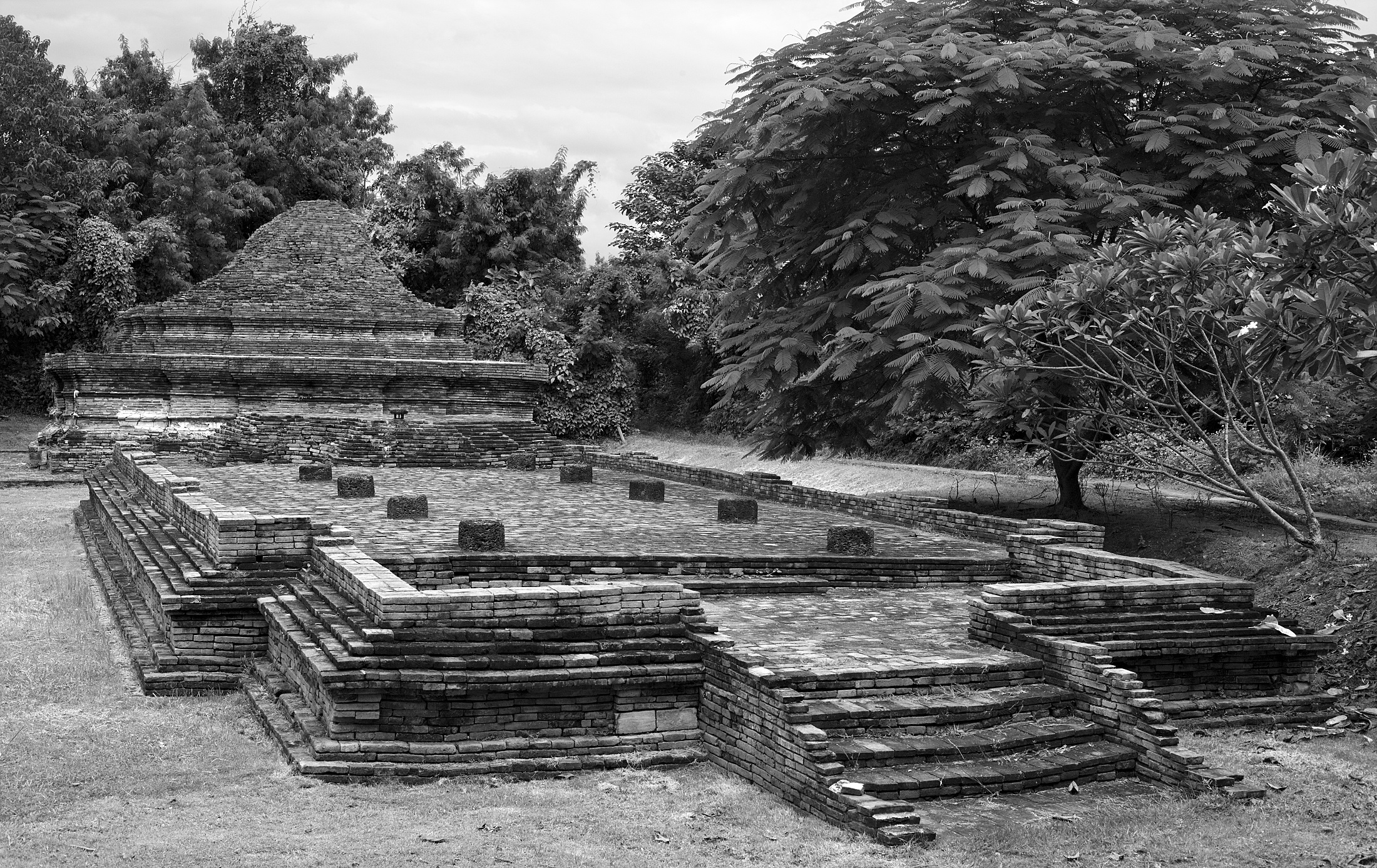Wiang Kum Kam on:
[Wikipedia]
[Google]
[Amazon]
Wiang Kum Kam ( th, เนเธงเธตเธขเธเธเธธเธกเธเธฒเธก; nod, แฉ
แฉ แจฟแจฆแจ แฉฉแจพแจ แฉฃแฉ แจพ) is an historic settlement and archaeological site along the











Ping River
The Ping River ( th, เนเธกเนเธเนเธณเธเธดเธ, , ), along with the Nan River, is one of the two main tributaries of the Chao Phraya River. It originates at Doi Thuai in the Daen Lao Range, in Chiang Dao district, Chiang Mai province. After pas ...
, which was built by King Mangrai the Great Mangrai ( nod, ; th, เธกเธฑเธเธฃเธฒเธข; 1238โ1311), also known as Mengrai ( th, เนเธกเนเธเธฃเธฒเธข),The name according to historical sources is "Mangrai", and this is used in most modern scholarly applications. "Mengrai", popularised by a 19 ...
as his capital before he moved it to Chiang Mai
Chiang Mai (, from th, เนเธเธตเธขเธเนเธซเธกเน , nod, , เนเธเธตเธขเธเนเธซเธกเน ), sometimes written as Chiengmai or Chiangmai, is the largest city in northern Thailand, the capital of Chiang Mai province and the second largest city in ...
. It was flooded and abandoned more than 700 years ago; that move became more understandable in 2005, when the ancient city was flooded three separate times as the river overflowed its banks in that area of Chiang Mai
Chiang Mai (, from th, เนเธเธตเธขเธเนเธซเธกเน , nod, , เนเธเธตเธขเธเนเธซเธกเน ), sometimes written as Chiengmai or Chiangmai, is the largest city in northern Thailand, the capital of Chiang Mai province and the second largest city in ...
.
History
Wiang Kum Kam is an ancient city ( th, เนเธงเธตเธขเธ ''wiang'' "walled city") located in Saraphi District in the northern region ofThailand
Thailand ( ), historically known as Siam () and officially the Kingdom of Thailand, is a country in Southeast Asia, located at the centre of the Indochinese Peninsula, spanning , with a population of almost 70 million. The country is bo ...
, around south of the southeastern corner of Chiang Mai
Chiang Mai (, from th, เนเธเธตเธขเธเนเธซเธกเน , nod, , เนเธเธตเธขเธเนเธซเธกเน ), sometimes written as Chiengmai or Chiangmai, is the largest city in northern Thailand, the capital of Chiang Mai province and the second largest city in ...
's city centre. According to the chronicle
A chronicle ( la, chronica, from Greek ''chronikรก'', from , ''chrรณnos'' โ "time") is a historical account of events arranged in chronological order, as in a timeline. Typically, equal weight is given for historically important events and lo ...
s and archaeological
Archaeology or archeology is the scientific study of human activity through the recovery and analysis of material culture. The archaeological record consists of artifacts, architecture, biofacts or ecofacts, sites, and cultural landscap ...
evidence, the old city was built by King Mangrai around the latter part of the 13th century.
The city was established as a new capital by the King after his victory over the Mon people
The Mon ( mnw, แแแฐแแแบ; my, แแฝแแบแแฐแแปแญแฏแธโ, ; th, เธกเธญเธ, ) are an ethnic group who inhabit Lower Myanmar's Mon State, Kayin State, Kayah State, Tanintharyi Region, Bago Region, the Irrawaddy Delta, and s ...
's kingdom of Hariphunchai, modern Lamphun
Lamphun ( th, เธฅเธณเธเธนเธ, ) is a town (''thesaban mueang'') in northern Thailand, capital of Lamphun Province. It covers the whole ''tambon'' Nai Mueang of Mueang Lamphun district. As of 2006 it has a population of 14,030. Lamphun lies north ...
. Due to repeated flooding, a new capital, Chiang Mai, was built a few years later. Wiang Kum Kam flourished during the reign of the Mangrai dynasty until the late 16th century.
The old city was then lost from history for many years after Chiang Mai was conquered by the Burmese in 1558. There is a presumption that it was seriously flooded again at this time and was finally abandoned. The people were moved back to this area again more than 200 years later with a new community, and it was then named Chang Kham village ().
In 1984, the Department of Fine Arts Unit 4 discovered remnants of the old city around Wihan Kan Thom () at Wat Chang Kham () and afterwards excavation was begun; since then many new remains have been found and restoration has proceeded since that time.
The main temple of the town is Wat Chedi Liam
Wat Chedi Liam ( th, เธงเธฑเธเนเธเธเธตเธขเนเนเธซเธฅเธตเนเธขเธก; "Temple of the Squared Pagoda"), formerly known as Wat Ku Kham ( th, เธงเธฑเธเธเธนเนเธเธณ; "Temple of the Golden Stupa"), is one of the wats in the ancient Thai city of Wia ...
(originally Wat Ku Kham), which is still occupied by monks.
List of sites
Note that this list is definitely incomplete.
Wat Chang Kham
Wat Chang Kham ( th, เธงเธฑเธเธเนเธฒเธเธเนเธณ; "Elephant-Propped Temple") is within the grounds of a working modern temple. It is adjacent to the Wat That Noi site. The name is derived from elephant figures supporting one of the structures.

Wat Chedi Liam / Wat Ku Kham
Wat Chedi Liam
Wat Chedi Liam ( th, เธงเธฑเธเนเธเธเธตเธขเนเนเธซเธฅเธตเนเธขเธก; "Temple of the Squared Pagoda"), formerly known as Wat Ku Kham ( th, เธงเธฑเธเธเธนเนเธเธณ; "Temple of the Golden Stupa"), is one of the wats in the ancient Thai city of Wia ...
( th, เธงเธฑเธเนเธเธเธตเธขเนเนเธซเธฅเธตเนเธขเธก; "Temple of the Squared Pagoda"), formerly known as Wat Ku Kham ( en, เธงเธฑเธเธเธนเนเธเธณ; "Temple of the Golden Stupa"), is named after its ancient five-level '' chedi'' (or Buddhist pagoda) of Mon style, which was copied from a similar structure at Wat Phra That Hariphunchai
Wat Phra That Hariphunchai ( th, เธงเธฑเธเธเธฃเธฐเธเธฒเธเธธเธซเธฃเธดเธ เธธเธเธเธฑเธข) is a Buddhist temple (''wat'') in Lamphun, Thailand. The temple's origins date from the 11th century but the central stupa is thought to originate in the ...
in Haripunchai (modern Lamphun
Lamphun ( th, เธฅเธณเธเธนเธ, ) is a town (''thesaban mueang'') in northern Thailand, capital of Lamphun Province. It covers the whole ''tambon'' Nai Mueang of Mueang Lamphun district. As of 2006 it has a population of 14,030. Lamphun lies north ...
). It is apparently the only ancient temple in the Wiang Kum Kam archaeological area that remains a working temple with resident monks. In keeping with its Mon roots, Brahma
Brahma ( sa, เคฌเฅเคฐเคนเฅเคฎเคพ, Brahmฤ) is a Hindu god, referred to as "the Creator" within the Trimurti, the trinity of supreme divinity that includes Vishnu, and Shiva.Jan Gonda (1969)The Hindu Trinity Anthropos, Bd 63/64, H 1/2, pp. 21 ...
, the Hindu
Hindus (; ) are people who religiously adhere to Hinduism.Jeffery D. Long (2007), A Vision for Hinduism, IB Tauris, , pages 35โ37 Historically, the term has also been used as a geographical, cultural, and later religious identifier for ...
creator, is venerated at the temple in addition to Buddhism.

Wat I Khang
Wat I Khang
Wat I Khang ( th, เธงเธฑเธเธญเธตเธเนเธฒเธ, ; ) is a ruined 16th or 17th century temple in the Wiang Kum Kam archaeological complex near modern Chiang Mai in northern Thailand.
It is named after the former prevalence of wild old world monkey ...
( th, เธงเธฑเธเธญเธตเธเนเธฒเธ; "Langurs' Temple") is a ruined 16th or 17th century temple named after the former prevalence of wild old world monkeys
Old World monkey is the common English name for a family of primates known taxonomically as the Cercopithecidae (). Twenty-four genera and 138 species are recognized, making it the largest primate family. Old World monkey genera include baboons ...
at the site prior to its excavation and restoration, which are known as ''khang'' in Thai. It has a large, mostly intact ''chedi''.

Wat Nan Chang
Wat Nan Chang
Wat Nan Chang ( th, เธงเธฑเธเธซเธเธฒเธเธเนเธฒเธ; "Nan Chang's Temple") is a ruined 16th or 17th century temple in the Wiang Kum Kam archaeological complex near modern Chiang Mai in northern Thailand.
Excavated from 2002 to 2003, the temple ...
( th, เธงเธฑเธเธซเธเธฒเธเธเนเธฒเธ; "Nan Chang's Temple") is a ruined 16th or 17th century temple. Excavated from 2002 to 2003, it primarily provides evidence of ancient flooding in the region, having been inundated by some 1.8 meters of sediment. It is speculated that it was built to face a now dried up route of the Ping River
The Ping River ( th, เนเธกเนเธเนเธณเธเธดเธ, , ), along with the Nan River, is one of the two main tributaries of the Chao Phraya River. It originates at Doi Thuai in the Daen Lao Range, in Chiang Dao district, Chiang Mai province. After pas ...
, a major transportation and trade route of historic periods.
Wat Phaya Mangrai
Wat Phaya Mangrai
Wat Phaya Mangrai ( th, เธงเธฑเธเธเธเธฒเธกเธฑเธเธฃเธฒเธข; "Temple of King Mangrai") is a ruined temple located within the Wiang Kum Kam archaeological site, very close to the south-eastern side of Wat Phrachao Ong Dam. It is named after the h ...
( th, เธงเธฑเธเธเธเธฒเธกเธฑเธเธฃเธฒเธข; "Temple of King Mangrai") is named after the historic figure Mangrai the Great Mangrai ( nod, ; th, เธกเธฑเธเธฃเธฒเธข; 1238โ1311), also known as Mengrai ( th, เนเธกเนเธเธฃเธฒเธข),The name according to historical sources is "Mangrai", and this is used in most modern scholarly applications. "Mengrai", popularised by a 19 ...
. Very close to the south-eastern side of Wat Phrachao Ong Dam
Wat Phrachao Ong Dam ( th, เธงเธฑเธเธเธฃเธฐเนเธเนเธฒเธญเธเธเนเธเธณ; "Temple of the Black-Bodied Lord") is a ruined temple that is part of the Wiang Kum Kam archaeological site which is located just outside the northern Thai city of Ch ...
.


Wat Phrachao Ong Dam
Wat Phrachao Ong Dam
Wat Phrachao Ong Dam ( th, เธงเธฑเธเธเธฃเธฐเนเธเนเธฒเธญเธเธเนเธเธณ; "Temple of the Black-Bodied Lord") is a ruined temple that is part of the Wiang Kum Kam archaeological site which is located just outside the northern Thai city of Ch ...
( th, เธงเธฑเธเธเธฃเธฐเนเธเนเธฒเธญเธเธเนเธเธณ; "Temple of the Black-Bodied Lord") is named after a burnt bronze Buddha image that was discovered at the site. Very close to the north-western side of Wat Phaya Mangrai
Wat Phaya Mangrai ( th, เธงเธฑเธเธเธเธฒเธกเธฑเธเธฃเธฒเธข; "Temple of King Mangrai") is a ruined temple located within the Wiang Kum Kam archaeological site, very close to the south-eastern side of Wat Phrachao Ong Dam. It is named after the h ...
.


Wat Pu Pia
Wat Pu Pia ( th, เธงเธฑเธเธเธนเนเนเธเธตเนเธข; "Temple of Old Man Pia") is notable for its relatively good state of preservation, including some stucco work and an intact layout.
Wat That Khao
Wat That Khao ( th, เธงเธฑเธเธเธฒเธเธธเธเธฒเธง; "Temple of the White Reliquary) is another ruined temple from the 16th or 17th century that is named after its formerly lime-plastered chedi.
Wat That Noi
Wat That Noi ( th, เธงเธฑเธเธเธฒเธเธธเธเนเธญเธข; "Temple of the Little Reliquary") is another ruined temple of the area, so named because of its restricted scale.See also
*Chiang Saen Chiang Saen may refer to:
* Chiang Saen District, in Chiang Rai Province, northern Thailand
* Chiang Saen, a capital of the ancient Lanna
The Lan Na Kingdom ( nod, , , "Kingdom of a Million Rice Fields"; th, เธญเธฒเธเธฒเธเธฑเธเธฃเธฅเนเธ ...
* Haripunchai
*History of Thailand
The Tai ethnic group migrated into mainland Southeast Asia over a period of centuries. The word ''Siam'' ( th, เธชเธขเธฒเธก ) may have originated from Pali (''suvaแนแนabhลซmi'', "land of gold") or Sanskrit เคถเฅเคฏเคพเคฎ (''ลyฤma'', "dark ...
*Lanna
The Lan Na Kingdom ( nod, , , "Kingdom of a Million Rice Fields"; th, เธญเธฒเธเธฒเธเธฑเธเธฃเธฅเนเธฒเธเธเธฒ, , ), also known as Lannathai, and most commonly called Lanna or Lanna Kingdom, was an Indianized state centered in present-day ...
References
{{Authority control Former populated places in Thailand Buildings and structures in Chiang Mai Buddhist temples in Chiang Mai Province 13th century in Chiang Mai